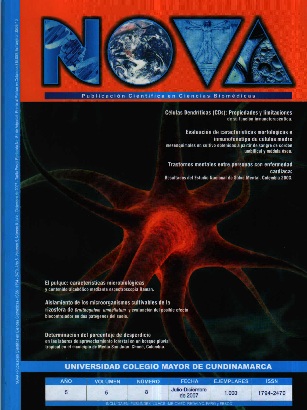Evaluación de características morfológicas e inmunofenotipo de células madre mesenquimales en cultivo obtenidas a partir de sangre de cordón umbilical y médula ósea.
Evaluación de características morfológicas e inmunofenotipo de células madre mesenquimales en cultivo obtenidas a partir de sangre de cordón umbilical y médula ósea.

NOVA por http://www.unicolmayor.edu.co/publicaciones/index.php/nova se distribuye bajo una Licencia Creative Commons Atribución-NoComercial-SinDerivar 4.0 Internacional.
Así mismo, los autores mantienen sus derechos de propiedad intelectual sobre los artículos.
Mostrar biografía de los autores
La sangre del cordón umbilical y la médula ósea humana son una alternativa para el aislamiento y cultivo de células madre mesenquimales, útiles en terapias de regeneración tisular e inmunomodulación. El objetivo de este trabajo fue aislar y cultivar células madre mesenquimales a partir de la sangre del cordón umbilical y de la médula ósea. Se recolectaron muestras de sangre de cordón umbilical en el servicio de Gineco-Obstetricia del Hospital Occidente de Kennedy en Bogotá, Colombia. La recolección de médula ósea se realizó en los servicios de ortopedia y traumatología del hospital universitario San Ignacio de Bogotá, Colombia. Se evaluó la tasa de generación celular, características morfológicas por microscopia invertida y tinción de Wright, asi como el inmunofenotipo de las poblaciones celulares por citometría de flujo.
La eficiencia de aislamiento de las células madre mesenquimales a partir de sangre de cordón umbilical fue del 30% con una tasa de generación entre 20 y 50 minutos. A partir de médula ósea el aislamiento fue del 100%, con un tiempo de generación entre 16 y 39 minutos. Se observaron diferencias morfológicas por tinción de Wright y la presencia de progenitores hematopoyéticos durante el cultivo primario (3.54% de CD34+/CD45+), que disminuían cuando se realizaba el primer pase del cultivo (0.19% de CD34+/CD45+). El aislamiento de células madre mesenquimales es más eficiente a partir de medula ósea.
Se observan diferencias morfológicas por microscopia invertida y tinción de Wright entre células aisladas de sangre de cordón umbilical y médula ósea. El antígeno CD105 constituye un marcador importante en el establecimiento del perfil inmunofenotípico de células madre mesenquimales.
Visitas del artículo 317 | Visitas PDF 150
Descargas
- Körbling M, Estrov Z. Adult stem cells for tissue repair – a new therapeutic concept?. N Engl J Med. 2003;349:570-582.
- Rodríguez V. Células Madre:Conceptos Generales y Perspectivas de Investigación. Universitas Scientiarum. 2005;10:5-14.
- Szilvassy S. The biology of hematopoietic stem cells. Arch Med Res. 2003; 34: 446-60.
- Kang X, Zang W, Bao L, Li D, Xu X, Yu X. Differentiating characterization of human umbilical cord blood derived mesenchymal stem cells in vitro. Cell Biol Int. 2006;30:569-575.
- Beyer N, Da Silva L. Mesenchymal Stem Cells: Isolation in vitro expansion and characterization. Handb Exp Pharmacol. 2006;174:249-282.
- Gregory C, Prockop D, Spees J. Non-hematopoietic bone marrow stem cells: Molecular control of expansion and differentiation. Exp Cell Res. 2005; 306:330-335.
- Bianco P, Riminucci M, Gronthos S, Robey P. Bone Marrow Stromal Cells: Nature, biology, and potencial applications. Stem Cells. 2001; 19: 180-92.
- Rasmusson I. Immune modulation by mesenchymal stem cells. Exp Cell Res. 2006;312:2169-2179.
- Deans RJ, Moseley AB. Mesenchymal Stem Cells: Biology and potential clinical uses. Exp Hematol. 2000;28:875-884.
- Lakshmipathy U, Verfaille C. Stem Cell Plasticity. Blood Rev. 2005;19:29-38.
- Wexler S, Donaldson C, Denning P, Rice C, Bradley B, Hows J. Adult bone marrow is a rich source of human mesenchymal «stem» cells but umbilical cord and mobilized adult blood are not. Br J Haematol. 2003;121:368-374.
- Baksh D, Song L, Tuan RS. Adult mesenchymal stem cells: characterization, differentiation, and application in cell and gene therapy. J Cell Mol Med. 2004;8:301-316.
- Wagner W, Wein F, Seckinger A, Frankhauser M, Wirkner U et al. Comparative characteristics of mesenchymal stem cells from human bone marrow, adipose tissue, and umbilical cord blood. Exp Hematol. 2005; 33:1402-1416.
- Kern S, Eichler H, Stoeve J, Klüter H, Bieback K. Comparative analysis of mesenchymal stem cells from bone marrow, umbilical cord blood, or adipose tissue. Stem Cells. 2006;24:1294-1301.
- Bieback K, Kern S, Klüter H, Eichler H. Critical parameters for the isolation of mesenchymal stem cells from umbilical cord blood. Stem Cells. 2004; 22:625-634.
- Sabatini F, Petecchia I, Tavian M, Jodon V, Rossi G, Brouty-Boye D. Human bronchial fibroblast exhibit a mesenchymal stem cell phenotype and multilineage differentiating potentialities. Lab Invest. 2005;85:962-971.
- Shi S, Bartold P, Miura M, Seo B, Robey P, Gronthos S. The efficacy of mesenchymal stem cells to regenerate and repair dental structures. Orthod Craniofac Res. 2005;8:191-199.
- Krampera Ma, Pizzolo G, Aprili G, Franchini M. Mesenchymal stem cells for bone, cartilage, tendon and skeletal repair. Bone. 2006;39:678-683.
- Krampera Mb, Pasini A, Pizzolo G, Cosmi L, Romagni S, Annunziato. Regenerative and immunomodulatory potential of mesenchymal stem cells. Curr Opin Pharmacol. 2006;6:435-441.
- Kassem M, Kristiansen M, Abdallah B. Mesenchymal Stem Cells:Cell biology and potential use in therapy. Basic Clin Pharmacol Toxicol. 2004; 95:209-214.
- Mankani MH, Kuznetsov SA, Fowler B, Kingman A, Robey PG. In vivo bone formation by human bone marrow stromal cells: effect of carrier particle size and shape. Biotechnol Bioeng. 2001;72:96-107.
- Tsuchida H, Hashimoto J, Crawford E, Manske P, Lou J. Engineered allogeneic mesenchymal stem cells repair femoral segmental defect in rats. J Orthop Res. 2003;21:44-53.
- Mazhari R, Hare JM. Mechanisms of action of mesenchymal stem cells in cardiac repair: potential influences on the cardiac stem cell niche. Nat Clin Pract Cardiovasc Med. 2007;4:S21-S26.
- De Bari C, Dell’ accio F, Vandenabeele F, Vermeesch IR, Raymackers JM, Luyten FP. Skeletal muscle repair by adult human mesenchymal stem cells from synovial membrane. Blood Rev. 2006;200:161-171.
- Tse WT, Pendleton JD, Beyer WM, Egalka MC, Guinan EC. Suppresion of allogenic T-cell proliferation by human marrow stromal cells: implications in transplantation. Transplantation. 2003;75:389-397.
- Le Blanc K, Tammik I, Sundberg B, Haynesworth SE, Ringden O. Mesenchymal stem cells inhibit and stimulate mixed lymphocyte cultures and mitogenic responses independently of the major histocompatibility complex. Scand J Immunol. 2003;57:11-20.
- Aggarwal S, Pittenger MF. Human mesenchymal stem cells modulate allogenic immune cell responses. Blood. 2005;105:1815-1822.
- Zhang W, Ge W, Li C, You S, Liao I, Han Q et al. Effects of mesenchymal stem cells on differentiation, maduration, and function of human monocyte-derived dendritic cells. Stem Cells Dev. 2004;13:263-271.
- Maurillo L, Del Poeta G, Venditti A, Bucciana F, Battaglia A, Santinelli S et al. Quantitative analisis of Fas and Bcl-2 expression in haematopoietic precursors. Haematologica. 2001;86:237-243.
- Chang Y, Tseng C, Hsu I, Hsieh T, Hwang S. Characterization of two populations of mesenchymal progenitor cells in umbilical cord blood. Cell Biol Int. 2006;30:495-499.
- Kortesidis A, Zannettino A, Isenmann S, Shi S, Lapidot T, Gronthos S. Stromal-derived factor-1 promotes the growth, survival, and development of human bone marrow stromal cells. Blood. 2005;105:3793-3801.
- Gonçalves R, Da Silva C, Cabra J, Zanjani E, Almeida-Porada G. A Stro-1+ human universal stromal feeder layer to expand/maintain human bone marrow hematopoietic stem/progenitor cells in a serum-free culture system. Exp Hematol. 2006;34:1353-1359.
- -----------------------------------------------------------------------------------
- DOI: http://dx.doi.org/10.22490/24629448.380





